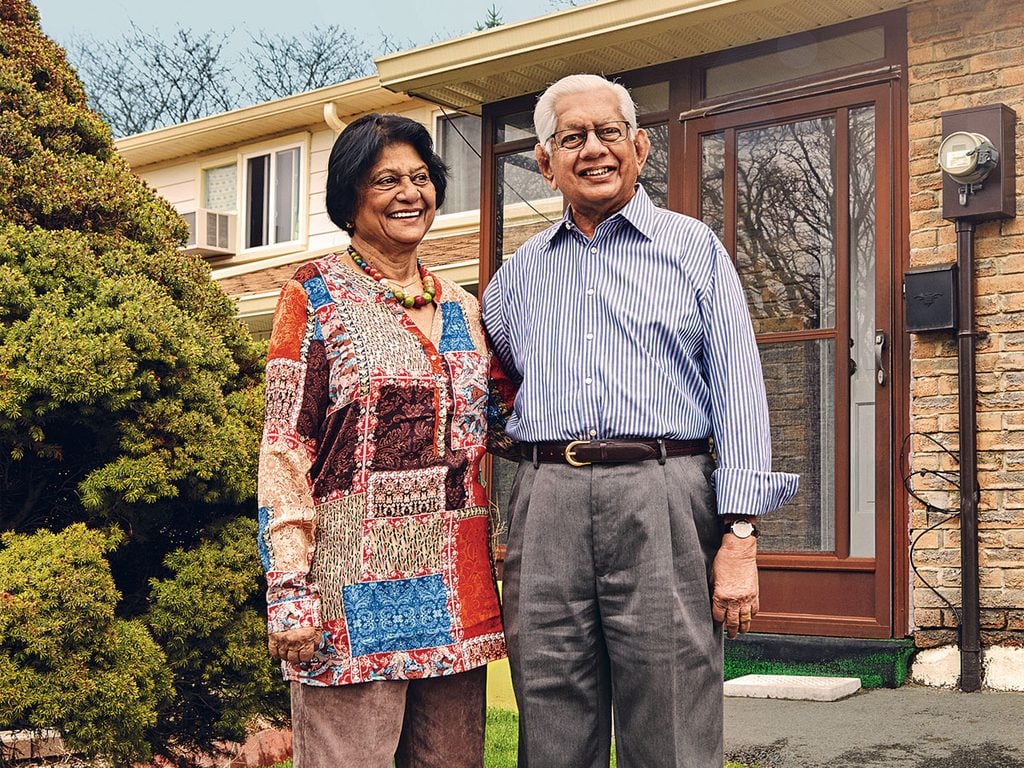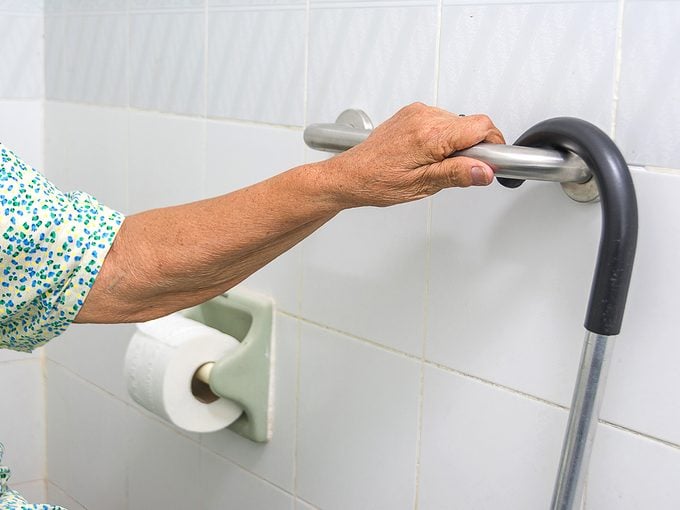Aging in Place: A Guide to Growing Older at Home

Ninety percent of Canadian seniors want to live in their homes for as long as possible. Here's how to make it happen.
Edna and Wimsy Sinnatamby, 83 and 87 (above), have lived in their modest Toronto townhome for more than three decades. It was the first house they bought in Canada, and it’s filled with treasured photos.
There are pictures of the couple at Wimsy’s 80th birthday celebration, alongside their three adult sons and four granddaughters. There are pictures of recent family reunions in Singapore, where the Sri Lankan couple has family, the women posing in dazzling saris. And then there is a faded eight-by-10 print of a much younger Wimsy, dressed in a fitted black suit and skinny tie, next to Queen Elizabeth and Prince Philip. The photo was taken two years before Wimsy and Edna fled to Canada to escape the civil war between their minority ethnic group, the Tamils, and the majority Sinhalese.
The couple gave up their financial stability to move here back in 1983, but eventually worked their way up to stable jobs: Wimsy in the credit-card-fraud department at one of the big banks and Edna as a home-daycare owner.
These days, the couple have real estate agents knocking on their door regularly, trying to persuade them to sell, but they wouldn’t dream of it. “I say, ‘Could I come live with you? Because I wouldn’t have anywhere to go,’” jokes Wimsy. Besides, Edna and Wimsy have found a community here.
When Wimsy slipped and fell a couple years ago, badly injuring his forehead, a neighbour arrived before the paramedics did. And when he got a hip replacement, friends and church members took turns driving Edna to and from the hospital. Over the decades, they’ve built a good life. And so, they want to stay.
More than 90 percent of seniors live at home and want to remain there as long as possible, according to a 2012 study by the Health Council of Canada. Despite that wish, if we reach the age of 85, Statistics Canada estimates there is a one-in-three chance we’ll have to live in a seniors’ residence or nursing home as our health and safety needs change.
But advocates for seniors insist that we’re losing our independence and our social communities too soon because we aren’t prepared to adapt and find the resources available to help extend our lives at home. And while the average life expectancy for Canadians is about 82 years, we’re living longer overall—centenarians are the second-fastest-growing age group, after baby boomers aged 60 to 64. More and more seniors will soon have to decide where, and how, they’ll age.
Despite numerous challenges associated with “aging in place,” it’s still by far many people’s preferred choice, and with good reason: experts say that the social connections, sense of autonomy and comforts of home are what’s best for older adults.
If you’re planning on growing older in your home, these tips will help you make the most of it.
Tips For Aging in Place
Look ahead
Most of us don’t plan our retirements as well as we could. It’s not all about saving for retirement: we also have to figure out what will be necessary to continue living at home long-term, such as accessing a complex system of government-funded home care and community programs.
“People don’t know how to navigate the system. They don’t know their rights,” says Danielle Pollack, a social worker and founder of Equinoxe, a Montreal health-care-management company with a focus on geriatric care. A 2013 report by Heart and Stroke found that during the last 10 years of life—when we deal with higher levels of disability and illness—our health is at its worst. It’s also when our care costs are at their highest. Still, an RBC poll showed that 83 percent of seniors would prefer to pay for home care as needed, rather than move into a seniors’ residence, long-term care facility or with relatives when their health takes a dip.
To prepare, speak with your doctor as soon as possible about pre-existing medical conditions and services you may need as you age, such as support to deal with diabetes, arthritis or depression. You’ll also need to have some serious discussions with family members and a financial adviser as part of that planning process. For instance, you might want to leave your house to your kids, or perhaps you’ll need to rely on them for help. The federal government has a useful checklist to help people organize aging in place. It helps you assess how prepared you are in nine different areas of your life, such as your health, home, finances and transportation.

Make home modifications to enable aging in place
A few simple changes can keep your home comfortable as you age, says Dr. Roger Wong, clinical professor of geriatric medicine at the University of British Columbia. “The essence is to make sure we maintain safety and quality of life,” says Wong. He points out that falls are the leading cause of injury-related hospitalizations among Canadian seniors, as 20 to 30 percent of people over 65 fall each year. Even a simple tumble can cause a broken hip, leading to disability and loss of independence.
Some of the easiest modifications you can make, says Wong, are installing grab bars in the shower, installing a raised toilet seat, decluttering and getting rid of excess furniture. And while wall-to-wall carpeting can be softer on falls, many seniors prefer hardwood floors—they’re easier to navigate with walking aids. Edna and Wimsy removed their loose rugs to prevent tripping and replaced their sofas with higher, firmer armchairs that are easier to get in and out of. After Wimsy’s hip replacement 10 years ago, the couple changed their bathtub to a walk-in shower, which cost around $3,000. And while the stairs in their townhouse are good exercise for now, they would opt to install a stairlift rather than move out.
Retrofitting your home to make it accessible can be expensive—anywhere from a few thousand to hundreds of thousands of dollars in renovation costs—but seniors may be eligible for a home-accessibility tax credit to help pay for these changes.
Embracing tech can also help you stay secure. Seniors should have their own smartphones (updated with emergency numbers) and learn how to use them when their memory is still good, says Wong. Smart watches, video monitoring and emergency personal response systems, such as MedicAlert or Lifeline, can also be critical to call for help.

Accept help at home
Even if you’re in good health, you’ll likely need to delegate some chores. The Sinnatambys have been married for 62 years; they take care of each other. Edna cooks, Wimsy drives, and they both like to go dancing (they call it “shuffling” these days). Still, a neighbour insists on carrying their trash bins to the bottom of the sloped driveway, which gets icy during the winter. And Edna has a shoulder injury, so she hires a cleaning service once a month to do some of the heavier lifting.
There are a number of public and private home-care options to help with personal-care tasks, such as bathing, dressing, grooming—and simply offering company. Home care provided by the provinces is evaluated on a needs basis and can include up to 50 hours a week near the end of life. Privately, home care averages around $30 an hour, including at nighttime.
During the daytime, you might also consider a private or subsidized adult day program, such as Calgary’s Age Care Glenmore’s Adult Day Support Program. Services like these provide health, social and recreational support for seniors and a break for their caregivers. Age Care Glenmore’s program costs only $10 a day and includes nutritious meals, fitness classes and activities, such as card games and gardening. While many programs cater to active seniors, others are geared toward older people who are frail, recovering from a stroke or have dementia, and are staffed with community nurses, social workers, volunteers and health-care students.

Maintain social support
Global research has warned of an epidemic of social isolation, and aging is a well-known risk factor, as critical life transitions, such as retirement, the death of a spouse or losing a driver’s licence, come into play.
In Canada, as many as 44 percent of seniors living in care facilities have symptoms of depression, and men over the age of 8o have among the highest suicide rate of all age groups. As well, researchers in the United States have found that lonely people are 50 percent more likely to die prematurely than those with healthy relationships.
While loneliness is not linked to any single disease, it is a risk factor for a wide range of illnesses and causes of death, as our stress, or “fight or flight” response to feeling isolated can trigger a cascade of hormones that cause physiological changes in the body. In fact, loneliness is even more dangerous than obesity and just as bad as smoking 15 cigarettes day, according to studies from Brigham Young University.
Community services, such as the Greater Toronto Area’s Social Services Network, can be a lifeline to vulnerable seniors, providing regular social opportunities, cultural events and informational talks at little or no cost, whether it’s a police presentation about fraud prevention or a health workshop about Alzheimer’s.
“There are a variety of funded services out there, and we’re trying to bring them to the table. A lot of seniors are not technologically adept enough to be able to search for them,” says Alykhan Suleman, the executive director of Social Services Network. Suleman says his organization has also started a pilot project to teach seniors how to use tech, including social media, which can help keep them connected. With the necessary social support, aging in place can also help people living with dementia—familiar surroundings can help them stay oriented, says Wong, although the speed of memory loss cannot be slowed down.
Learn how to spot the early signs of dementia.
Manage money wisely
Aging in place is often the most affordable option, especially if you don’t need to get out of debt or require 24/7 care. While you may be spending money on making your home more accessible and paying for some help around the house, there are grants and other taxable benefits to help lower those costs—pension credits, property tax rebates, home-accessibility tax credits, disability supports, medical coverage and rental subsidies, to name a few. Speak with a certified financial planner, as well as an accountant or tax expert who’s up to date on the latest benefits for seniors. Ideally these conversations should start happening during pre-retirement, at age 50.
If you have a mortgage or other debt, however, downsizing to somewhere more affordable or moving to a seniors’ residence might be a wiser decision says Rick Lowes, vice-president of retirement strategy at RBC.
Depending on where you live, rent in a basic seniors’ residence can run anywhere from $1,500 to $3,500, or over $10,000 a month for higher-end amenities. “It’s hard to understand the financial implications of moving from your home. People often find themselves in a position where they need to act immediately, and they’re scrambling,” says Lowes. He recommends speaking with a financial planner, who can help you anticipate the costs of significant health issues and how they will fit in with your income in retirement.
Alternatives to aging in place
Sometimes aging in place just isn’t possible. It may cease to be safe if you’re dealing with mobility or cognitive issues, or become unrealistic if you can’t afford support, or your family is burning out from caregiver stress.
You might choose to move to a seniors’ residence, and then to a longer-term care home, which can be co-paid or fully subsidized by the province, says Audrey Miller, social worker, founder and managing director of Elder Caring Inc. in Toronto.
Every step of the way, says Miller, there’s help. “We want people to know that they’re not alone in this,” she adds. “There are a lot of ways to be creative about where and how you’re going to age. Boomers are the generation that’s looking for that.”
Edna and Wimsy have learned to live with some health challenges related to getting older, such as injuries and health scares. Earlier this year, Wimsy had another slip on the sloped driveway and needed stitches in the back of his head, but he recovered quickly.
Throughout these setbacks, they both still count their blessings daily and manage to stay active and intellectually engaged. While their kids want them to downsize to a condo to avoid having to deal with house repairs, stairs and that iffy driveway, that’s not how they picture growing old together. Their hard-won home and community feel too comfortable to abandon. “What you put into your life and marriage is what you will reap when you’re older,” Edna says.
Now that you know what’s involved in aging in place, explore some of the new alternatives to retirement living.







